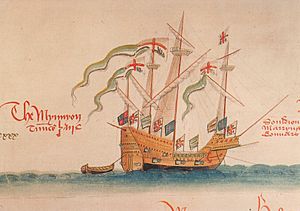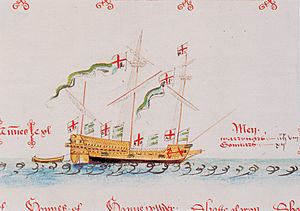William Wynter facts for kids
Quick facts for kids
Admiral Sir
William Wynter
|
|
|---|---|
| Born | c. 1521 Brecknock, Powys, Wales |
| Died | 20 February 1589 |
| Years of service | 1544-1589 |
| Rank | Admiral, Vice-Admiral of England |
| Commands held | Admiral of the Irish Sea Master of Naval Ordnance Surveyor and Rigger of the Navy Keeper of the Storehouse, Deptford Yard |
| Battles/wars | Siege of Leith Spanish Armada |
| Spouse(s) | Mary Langton |
Admiral Sir William Wynter (born around 1521 – died February 20, 1589) was a very important leader in the English Navy. For 40 years, from 1549 until his death, he was the chief engineer and ship repairer for the Navy. From 1557, he was also in charge of all naval weapons.
Sir William was a top officer in the Navy's main council under Queen Elizabeth I of England. He served England during the war with Spain (1585–1604). He was also elected to parliament four times during Queen Elizabeth's reign.

Contents
Early Life and Family
William Wynter was born in Brecknock, Wales. He was the second of five sons. His father, John Wynter, was a merchant and sea captain from Bristol. John also served as the Navy's Treasurer.
William's mother was Alice Tirrey from Cork, Ireland. William's brothers, Arthur and George Wynter, also held important jobs in the Navy.
William Wynter learned about the Navy from a young age.
Early Missions
- In 1544, he joined a large fleet of 260 ships. This fleet attacked and burned Leith and Edinburgh in Scotland.
- In 1545, he served in Lord Lisle's fleet in the English Channel.
- By July 1546, he was in charge of the King's Storehouse at Deptford.
- In 1547, he took part in an expedition to Scotland. This led to a victory at the Battle of Pinkie.
- In 1549, he joined a mission to Guernsey and Jersey.
In April 1549, William Wynter became the Surveyor of the Navy. This meant he was responsible for building, repairing, and equipping ships. He held this job until he died in 1589.
In 1557, Wynter was also put in charge of the Navy's weapons as the Master of Navy Ordnance. He held both of these important jobs for the rest of his life.
Captures and Voyages
In December 1549, while commanding the ship Mynion, he captured a French ship. This ship was full of sugar. The crew of 300 shared a reward of £100.
In 1550, he oversaw the moving of ships from Portsmouth to Gillingham in the Thames Estuary. He also went on a voyage to Ireland in 1552 and to the Middle East in 1553.
In 1554, Wynter was held in the Tower of London. He was suspected of being involved in a rebellion against Queen Mary I of England. He was pardoned in November of that year.
Marriage and Family Life
Around this time, William Wynter married Mary Langton. Her father was a merchant in London. William and Mary had several children, including their eldest son, Edward Wynter, born in 1560.
Mission to Scotland (1559-1560)


In January 1560, Wynter was sent with a fleet to Scotland. This was during a time when Protestant lords in Scotland were fighting against the Catholic Regent, Mary of Guise. She was supported by French soldiers.
Wynter's job was to stop French ships from landing more troops in Scotland. He left England in his ship, the Lyon, on December 27. He sailed with 12 warships and two supply ships. A storm scattered his fleet, but he continued to Berwick upon Tweed. There, 600 soldiers joined his ships.
Wynter's Fleet in the Firth of Forth
Wynter was ordered to block any French landings in the Firth of Forth. He was told to pretend his arrival was an accident. On January 21, 1560, his ships entered the Firth of Forth.
Wynter's blockade worked immediately. It stopped the French from sending supplies by sea from Edinburgh. He captured two French ships loaded with weapons. This forced the French commander, Henri Cleutin, to travel by land.
On January 24, 1560, a Scottish messenger asked Wynter why he was in Scottish waters. Wynter pretended he was on his way to Berwick and had entered the Forth by chance. He said he decided to help the Scottish Protestants against the French. He claimed Queen Elizabeth knew nothing about it.
This "secret" mission helped England and the Scottish Protestants make a deal. The Scottish lords signed the Treaty of Berwick with England. This treaty allowed England to send an army to help the Scots.
Siege of Leith
Wynter's fleet continued to attack French ships. He then helped the English army during the Siege of Leith. He burned seven French ships and cut off all supplies from France. His ships also fired cannons at the town.
The siege ended with the Treaty of Edinburgh in 1560. This treaty effectively ended the old alliance between Scotland and France. Wynter was praised for his actions.
Peacetime and Other Projects
After the war, William Wynter bought a large estate called Lydney Manor in Gloucestershire. This became his home.
In 1561, Wynter helped save the Bishop of London's Palace from fire. He advised the Mayor of London to tear down part of a nearby church roof. This stopped the fire from spreading.
Wynter also helped plan a voyage to Guinea in Africa to explore the coast and look for resources.
In 1563, William served in the fleet near Le Havre. In 1570, Queen Elizabeth sent him to escort Anne of Austria on her sea journey to marry the King of Spain.
William Wynter faced some challenges in his career. His brother George Wynter was also a Navy officer. In 1577, John Hawkins was chosen to be the Treasurer of the Navy instead of William. This would have doubled William's income.
Hawkins then accused Wynter and others of bad management and corruption. Even though there were arguments, both Hawkins and Wynter kept their jobs. Wynter later supported accusations against Hawkins.
Despite these rivalries, Wynter was highly respected. Writers like Richard Eden and William Bourne dedicated their books to him. They praised his knowledge of naval affairs and his bravery.
Operations in Ireland
In 1571, one of Wynter's ships was captured by an Irish rebel leader, James Fitzmaurice Fitzgerald.
In 1579, Wynter commanded a fleet off the coast of Ireland. He blocked sea routes and captured ships of a papal invasion force. This force was trying to help an Irish rebellion. Wynter also helped in the siege of Carrigafoyle Castle.
The Spanish Armada
On July 21, 1588, Sir William Wynter joined the main English fleet near Calais. He suggested using fire-ships to drive the Spanish fleet from their anchorage. This plan worked!
He took part in the Battle of Gravelines on July 29. This was one of the few times in his career he was in very heavy fighting. During the battle, he was badly hurt when a cannon fell over.
Wynter was one of the few who fully understood how strong the English Navy's defense was. He believed the Spanish could not invade England without many more transport ships. His portrait was even included in the famous Armada Tapestries.
Important Jobs Held
Sir William Wynter held many important positions:
- Served on missions against Scotland (1544, 1547)
- Served in the Channel Fleet (1545)
- Keeper of the Deptford Storehouse (1546)
- Surveyor and Rigger of the Navy (1549-1589)
- Master of Naval Ordnance (1557-1589)
- Admiral in all sea missions (1557-1588)
- Justice of the Peace for Gloucestershire (from about 1564)
- Commissioner of Sewers for Kent, Surrey, and Sussex (1564)
- Mission to the Prince of Orange (1576)
- Constable of St Briavels Castle and Keeper of woods in the Forest of Dean (from 1577)
- Steward and Receiver for Duchy of Lancaster lands in Gloucestershire and Herefordshire (from 1580)
Sir William Wynter died on February 20, 1589, at the age of 68. He asked to be buried in the chapel he had built at Lydney church.
Children
William Wynter and his wife, Mary Langton, had several children:
- Edward Wynter (1560-1619), who became a Member of Parliament.
- Nicholas Wynter, who died fighting Spaniards.
- James Wynter, who died young.
- William Wynter.
- Maria Wynter, who married Thomas Baynham.
- Elizabeth Wynter, who married William Morgan.
- Eleanor Wynter, who married George Huntley.
- Jane Wynter.
- Sarah Wynter.



